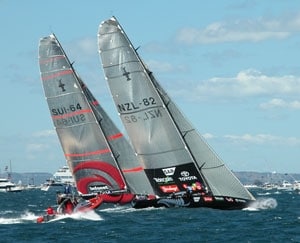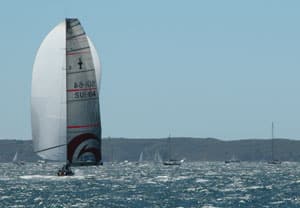
For Team New Zealand, the race was over almost before it began. Due in large part to a disastrous series of events aboard a Kiwi boat that appeared woefully unprepared for the task-and which was forced to retire due to multiple gear failures midway up the first leg-Switzerland’s Alinghi Challenge sailed the majority of the course alone this afternoon to take a remarkably easy 1-0 lead in the best-of-nine series for the America’s Cup.
The good news for the New Zealanders is that its hard to imagine another race where so many things could go so terribly wrong. The bad news is that on a day that began with so much promise and optimism, after a single race the Kiwis second Cup defense appears to be uncharacteristically vulnerable.
With blue skies overhead and a 20- to 25-knot southerly breeze coursing up the whitecap-flecked Hauraki Gulf, the on-the-water scene was reminiscent of the 1987 Cup races off Fremantle, Australia. A mammoth spectator fleet was on hand to witness the opening act in one of the most dramatic match-ups in the history of New Zealand sport: the Swiss boat, SUI-64, skippered by the expatriate Kiwi Russell Coutts, versus the TNZ defender, NZ-82, helmed by his 29-year-old protégé, Dean Barker.
It proved to be a day, however, when the pupil would offer scant competition to his teacher. With a high-pressure system parked over New Zealands North Island, earlier in the week it was feared that the opening weekend races in the Cups 31st defense might be cancelled due to a lack of breeze. But the passage of an overnight front brought fresh southerly winds gusting to 27 knots, and racing commenced in stiff, ideal conditions for yacht racing. Ironically, in the Louis Vuitton Cup lead-up to determine the Americas Cup challenger, the upper wind-speed limit for racing was just 19 knots. And on the numerous days that Louis Vuitton racing was cancelled due to heavy air, the Kiwis were often underway and practicing while the challengers remained dockside. The pre-Americas Cup supposition was that the New Zealanders might hold the edge in gusty conditions; there is no upper wind-speed limit for the Cup regatta. But as circumstances unfolded, it was the Alinghi crew that was undaunted by the fresh Hauraki Gulf pressure.
All that said, the race began in dramatic fashion, and in the early stages it appeared that SUI-64 and NZL-82 were evenly matched. With the windward mark set at 190 degrees Alinghi entered the starting box from the starboard side and was soon engaged in a game of cat-and-mouse with the Kiwis. When Alinghi jibed away beyond the starboard end of the committee boat the New Zealanders followed in close pursuit. With two minutes to the start both boats hardened up for the line with the Kiwis holding the windward advantage.
Both crews timed the start perfectly and hit the line in unison. For the Kiwis, however, it was the high point of the day. From that point onward, things would soon start going drastically downhill.
In the early drag race the New Zealanders appeared to have a slight edge in upwind pace but it was a short-lived advantage. A slight left-hand shift favored the Swiss and their cause was aided by a surprising development aboard NZL-82: an incredible ingress of water pouring in over the yachts gunnels which kept a Kiwi crewman bailing bucketful after bucketful over the side for all he was worth.
“It looks like the Southern Ocean,” said commentator Paul Cayard during the New Zealand television coverage. “Liquid Himalayas on the Hauraki Gulf.”
“It was unique to the day,” Barker said later. “We hadnt experienced that before. Its something were going to have to address.” Hes not kidding. But Barkers problems were just beginning.
As Coutts and Alinghi slowly closed gauge on the New Zealand yacht, Barker tacked away and soon after was confronted with the days first real disaster, a broken aft section of NZL-82s boom, which rendered the mainsail next to useless. “Once the boom broke we knew it was going to be a struggle,” said Barker. “It went from bad to worse.” It certainly did.
|
|
| |
|

|
| |
| Stuart Streuli|
| |
|
|
| |
| With Team New Zealand out of the race after two serious gear failures, Alinghi sails to victory all by itself.* * *|
| |
|
|
|
As the Kiwi crew struggled to address the spar damage, the tack fitting for the headsail broke free and the luff on the genoa separated from the headfoil. The dominoes were falling. Aboard the media boat following the action one journalist summed up the general sense of disbelief at the surprising turn of events: “Shocka.” “When something does break it loads up the other parts of the boat,” Barker said later. “When the tack broke it was going to be tough for us to make a race of it.” In fact, the race was over. The New Zealand crew tried to rehoist the genoa but the track was irreparably damaged. Moments later the Kiwis dropped the main, took a tow, and withdrew due to mechanical failure. Just halfway up the first beat, the Alinghi team was able to continue sailing and went on to complete the course alone and in stress-free style to take the first race of the Americas Cup.
Earlier in the day, the New Zealanders had left their berth at the Viaduct Harbor to a rousing send off by hundreds of boats and thousands of shoreside spectators. A helicopter hovered overhead flying a gigantic black banner bearing a one-word message that has become their rallying cry: “Loyal.” At the Louis Vuitton Media Center, tears of joy streamed down the face of a Kiwi security guide. By the end of the day, if tears were being shed by Kiwi supporters, it was for an entirely different reason.









